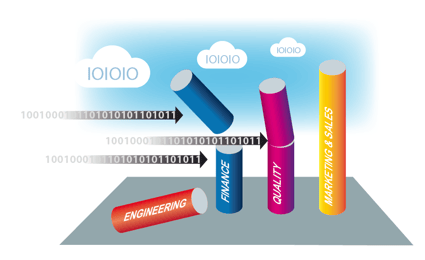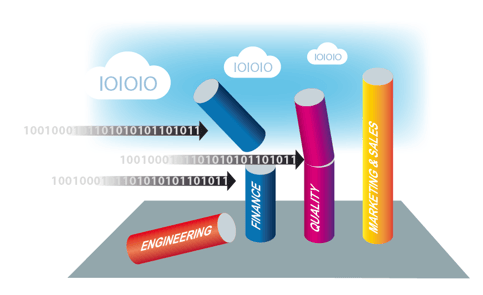4 Fascinating Facts About Supply Chain Digitization
Brian Hoey - April 05, 2018

 In the past few years, supply chain digitization has evolved from a hypothetical into a reality for many manufacturing businesses. The digital supply chain has become in many ways a key component of the rise of Industry 4.0, pushing businesses to adopt increasingly digitized planning and reporting solutions cross-operationally in order to stay competitive. Going forward, digitization’s importance is likely to continue increasing as companies strive to build more integrated and transparent operations. Here are a few fascinating facts about digitization in the supply chain.
In the past few years, supply chain digitization has evolved from a hypothetical into a reality for many manufacturing businesses. The digital supply chain has become in many ways a key component of the rise of Industry 4.0, pushing businesses to adopt increasingly digitized planning and reporting solutions cross-operationally in order to stay competitive. Going forward, digitization’s importance is likely to continue increasing as companies strive to build more integrated and transparent operations. Here are a few fascinating facts about digitization in the supply chain.
1. Its aim is to remove siloes
The digital supply chain gets discussed at length in the world of supply chain management, but what many people don’t realize is that the primary aim of supply chain digitization is to reduce planning and information siloes. Where manufacturing used to operate via a set of disparate, disconnected planning functions with little or no insight into one another’s workflows, resulting in inventory shortages or overages, production slowdowns, and inefficient resource management, the modern era holds more and more examples of integrated, digitized planning and execution. By offering real-time, digital updates on production planning, marketing, transport, and other key processes, the digital supply chain helps to cut through the obscurity and miscommunication that leads to waste and bottlenecks.
2. It promotes collaboration
By eliminating planning siloes and promoting an open and transparent digital ecosystem, supply chain digitization also goes a long way towards promoting cross-operational collaboration. This added level of collaboration can be a significant value-added proposition for manufacturing businesses, especially in cases where a more integrated approach to planning could help drive a leaner and more efficient supply chain. In a more collaborative environment, key stakeholders can work together to smooth out potential rough patches in various workflows, staving off or mitigating bottlenecks and breakdowns in the process.
3. It’s related to Postmodern ERP
While many commentators tout the importance of supply chain digitization, they sometimes do so without digging into the technical nitty-gritty that makes a digital supply chain possible. As a result, supply chain managers might not realize that the process of digitization can actually be very closely related to Postmodern ERP. As a refresher, Postmodern ERP is a reaction to modern ERP (enterprise resource management), in which companies, rather than selecting a one-size-fits-all IT solution for all departments, adopt a holistic IT infrastructure that connects multiple disparate platforms into a single, interoperable system.
In this way, it is possible to decrease the likelihood that departments will implement Shadow IT, i.e. software solutions that don’t have the official buy-in of company leadership of actual IT staff. Decreasing Shadow IT can add significant value in its own right, but the connective tissue that joins these separate, specialized solutions together can also become the backbone of a digital supply chain. After all, digitization is fundamentally about promoting connectivity and end-to-end (E2E) visibility, which Postmodern ERP consistently strives to do. By boosting interoperability and driving toward a connected planning funnel that unites the efforts of all business functions, manufacturers can truly create a digital supply chain that fits into the emerging frameworks of Industry 4.0.
4. It can improve advanced analytics
If the facts related above seem to suggest that supply chain digitization is a crucial driving force in today’s modern manufacturing environment, that’s because some of the most significant advances currently being made in supply chain concepts and technologies center around digitization and digitized manufacturing. To wit, one of the most powerful tools that can be integrated into digitized systems and workflows is advanced analytics, which can offer otherwise inaccessible insights into the workings of one’s value stream. Advanced analytics depends on large quantities of centralized, reliable data that would be virtually impossible to provide without a high degree of digitization and E2E visibility. With a transparent and digitized value chain, however, manufacturers can use advanced analytics to:
- Improve demand forecasts with predictive analytics;
- Uncover potentially cost-saving workflow improvements;
- Optimize complex processes like inventory management and job shop scheduling;
- Predict and prepare for potential disruptions, like sudden demand fluctuations or machine outages.
In this way, the digital supply chain represents more than a means of boosting visibility or collaboration; it represents a foray into the future of manufacturing and an embrace of Industry 4.0 principles. As new and exciting developments in modern manufacturing emerge, expect a digital supply chain to be a prerequisite for getting the most value out of new technologies.
LATEST POSTS
- Understand Circular Economy in The Manufacturing Industry
- How Can Industry 4.0 IT Integration Be Achieved Smoothly?
- The Significance of Order Sequencing in Discrete Manufacturing
- How to improve your Supply Chain Management: The Power of Control Towers
- Optimizing Human Resource Scheduling in Manufacturing: A Technological Approach



